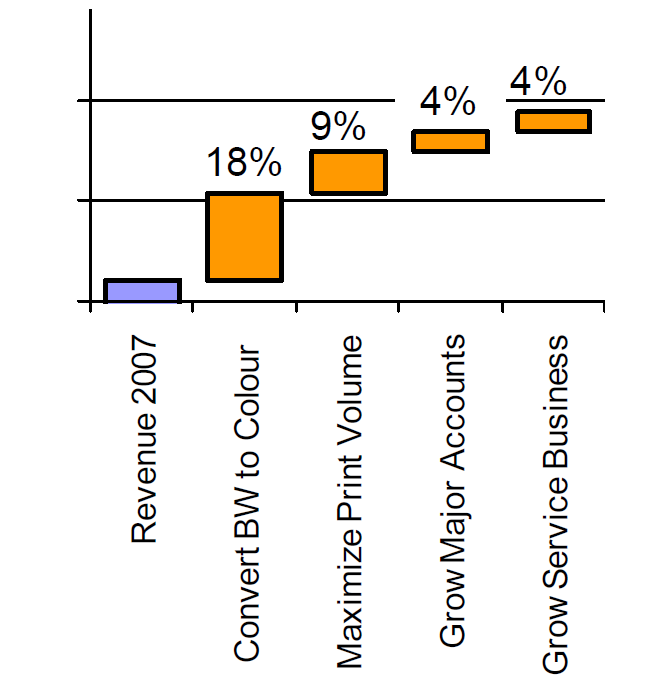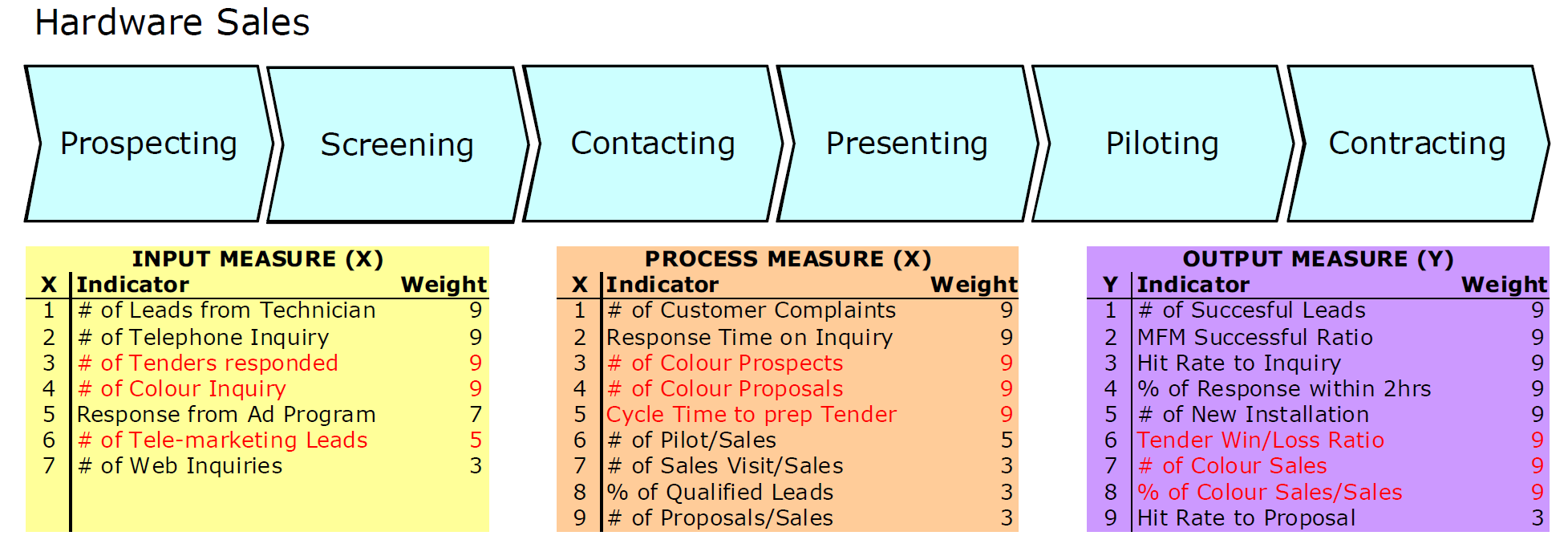Strategy Deployment is Key
Strategy Deployment is as Important as Having the Right Strategy.
Developing a compelling vision and mission statement as well as a sound strategy is vital for any organisation. Equally important is the translation of the strategy, the strategy deployment, into the day-to-day business.
This step becomes even more critical for multi-national companies with their need for regional adaptation and alignment with corporate at the same time. So, how do we make sure our mid- and long-term plans – developed in the head quarter – make sense to business leaders and employees in other regions?
Step 1: Tailoring Corporate Strategy for Local Realities
Our client, a Japanese office equipment manufacturer with ambitious growth targets, called for a strategy deployment meeting. Input for the meeting was a well written Mission Statement together with the comprehensive Strategy Map, based on the principle of the Balanced Scorecard divided into the sections Financials, Customers, Processes and Learning & Growth. The Japanese head quarter had developed Global Strategic Outcomes feeding into the Strategy Map (Figure 1).
Although the input given was quite clear, three major questions arose before the meeting:
- How do we adapt this strategy map to our different businesses with their distinctive heritage all over the Asia pacific region?
- How can we make sure we support the “One Business” idea even though we respect our differences?
- Can we put a process in place that avoids asking the first two questions every year again?
The answer to these questions lies in the methodology used to deploy the strategy. On the one hand, this methodology should give a clear framework of requirements and steps for strategy deployment. On the other hand, it should leave enough room for flexibility to adjust for local realities and prerequisites.
The answer to these questions lies in the methodology used to deploy the strategy. On the one hand, this methodology should give a clear framework of requirements and steps for strategy deployment. On the other hand, it should leave enough room for flexibility to adjust for local realities and prerequisites.
During the Strategy Deployment Meeting, each of the local teams – MD together with his management team – used their knowledge about customers and competition to refine the key strategic outcomes for their own business. Since the Strategic Outcomes were very high level, they needed to be broken down into supporting Strategic Elements (Figure 2).
For each Global Strategic Outcome some Strategic Elements were developed. Although both, Global Strategic Outcomes and main Strategic Elements were the same for all businesses in Asia Pacific, the focus (the weight) was different depending on country, customer structure, market share and maturity level.
Step 2: Strategy Deployment by Projecting Strategy into Processes
Nowadays, many companies deliver state-of-the-art products or services that do not differ significantly from those of competitors. Hence, the real difference and the value proposition for many companies does not lie in product or services but often in the way and the time-frame products/services are designed, made, delivered, serviced etc. This is where processes are of fundamental importance.
A process is a collection of related, structured activities or tasks that produce a specific service or product for customers (Appian). Apart from Management Processes, the processes of strategy management and governance, each company consists of a collection of Core Processes (like marketing, sales, design, purchasing, manufacturing and delivery) and Support Processes (like accounting, hr management and systems support).
Both, core processes and support processes are vital for translating strategy into action. However, the importance of these processes varies depending on the strategy.
One way to determine the importance, the weight, of a process is to project strategic elements and their weight into processes using a “Contribution Factor”. This Contribution Factor answers the question “How strong is the contribution of a given process on a certain strategic element?” and can become 0 for “no contribution”, 1 for “weak contribution”, 3 for “medium contribution” and 9 for “strong contribution”.
This matrix, applied on core processes (Figure 3 shows the matrix for one of the business units), delivers Hardware Sales, Service Management and Order Fulfilment as critical. I.e. process capability of these processes and competency of their human resources are keys for meeting strategic objectives.
Knowing that the weight of strategic elements incorporates the Voice of the Customer, we can assume achieving improvement in customer satisfaction and loyalty by working on these processes at the same time. Support processes (enabling processes) may be included in the matrix (Figure 3) or may be mapped against core processes.
Both ways, the influence of these processes on the strategy will be represented. Support processes are as vital as core processes. In our case, human resources management including recruitment and competency development have an essential role in preparing sales force, technicians and other staff for dealing with the new type of hardware. Training was to be set up by the affected business units. Tests and exams had to be conducted regularly to keep the level of knowledge and skills consistently up-to-date even in an ever faster changing technical environment.
Strategy is normally explained in lagging indicators of which Revenue and Profit are the most obvious. Apparently, lagging indicators cannot be used for leading a business since they only show up after the processes are over. Therefore, leading indicators need to be developed that are used by leaders to steer their area of responsibility. These indicators are usually put together in a kind of “Dashboard” to be reviewed frequently and conclusions drawn from them (Figure 4).
Step 3: Defining a “Dashboard” to Steer the Business
Mapping the core process Hardware Sales and listing its current leading indicators, its KPIs (Figure 4) revealed a picture that is typical for any sales process: Focus is on producing leads and converting these leads efficiently and effectively into sales results. Logically, the Output Measures (Output KPIs) of the process Hardware Sales should be appropriate to drive our strategy, i.e. strategic targets should be reflected in Output Measures of underlying processes.
However, comparing Output Measures and the strategic elements listed in Figure 3 shows immediately, that our key strategy of “Moving our clients from Black/White to Colour Machines” is not supported by any KPI in the Hardware Sales process. As a result, sales force in this business unit may do what they were used to do and they do best: selling the cheaper black/white machines to their customers and trying to avoid promoting the new, more expensive, more complicated equipment. The perception was that the additional per-box-income (and sales bonus) they could make with colour boxes would be eaten by the more complex sales process and – probably most important – by the need for upgrading their knowledge and skills.
Since we had earlier appointed Hardware Sales as the most important core process for driving this part of the strategy, the discovered mismatch was to be resolved. There was no question, if we wanted to get our company and ourselves fit for the future and implement our strategy we need to step out of our comfort zone. The regional teams had to amend the set of measures they wanted to use to lead the business. The KPI system – the “Leader’s Dashboard” – as well as personal target setting included more measures focussing on driving “Colour Sales” (Figure 5).
On the basis of the new set of measures specifications to be set, the current performance was to be established and compared against the specifications. Setting specifications can be challenging for newly defined KPIs. However, often it is possible to determine a baseline and draw conclusions about targets even for new KPIs based on the experience of process owners.
Step 4: Creating Ownership and Accountability Boosts Strategy Deployment
Understanding how strategy is driven by each process and by all employees and setting up a system to make this link measurable and actionable marks the foundation of an effective process management system. This system will only be used and work smoothly if
- People understand the system and buy-in.
- The system is constantly being optimised to keep it up-to-date and credible.
- The management walks the talk.
Strategy deployment will only be effective if all these ingredients are in place.
Therefore, individual accountability at all levels has to be established at all levels including reward & recognition systems. Dashboards have to be linked to personal scorecards and have to be used for appraisal of all personnel. Showing and explaining to each employee how the linkage between KPIs in their process step and the strategy works makes them understanding their role in the company’s clockwork and creates relevance of the strategic goals to everyone.
Leaders have to be aware that their accountability and responsibility is not limited to the outcomes of their processes but stretches over the whole process and includes even the system running this process. Only then, they have a chance to adapt their process quickly and smoothly to changes in strategy.
Lastly, they have a chance to strengthen their decision making process with supporting data from their business dashboard.
Step 5: Identifying Gaps and Improving Performance
Having targets and current performance enables the process owner to draw conclusions about improvement activities necessary and potential application of appropriate methods such as Lean Six Sigma, LIT or WorkOut.
After the strategy deployment event and implementing the process management system as described above, our client started various improvement activities to tackle performance gaps.
On the one hand, having an effective PMS in place delivers not only information about the need and the scope for these activities, it also provides valuable details about root causes for issues such as delays and defects and serves as a basis for monitoring processes after implementing changes.
On the other hand, this system gets amended, improved and fine-tuned by Black or Green Belts and their data analysis work in processes.
Strategy Deployment – Conclusion
Strategy Deployment is as important as having the right strategy. Processes are key to drive the business towards strategy. Indicators show whether the processes move in this direction with the right speed and give appropriate information for corrections. Leaders and staff need to understand this “Process Management System”. They need to know which role they play and how they contribute to the strategy.











